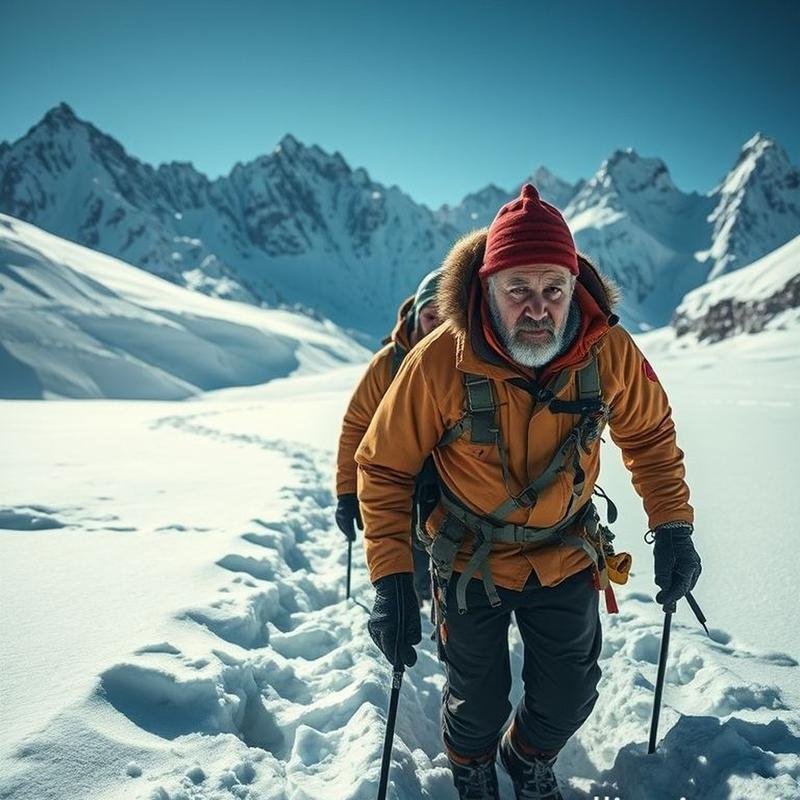Near-Death Experience Survivors: Profound Transformations Following Their Encounters.

Near-Death Experience Survivors: Profound Transformations Following Their Encounters.
December 1972, the towering Andes Mountains. A Uruguayan Air Force plane, Flight 571, crashes violently, scattering its white wreckage across the deadly snow. Forty-five souls, including a rugby team, face an uncertain fate. The initial shock manifests in piercing screams, shattered bones, and blood that freezes instantly. The search is called off after eight days, and despair weighs heavily on everyone, but amidst this frozen inferno, the flame of hope has not yet been extinguished.
Seventy-two days of agonizing torment. Bone-chilling cold, relentless hunger, and suffocating isolation. The temperature plummets to thirty degrees below zero. They fashion makeshift sleeping bags from the plane wreckage, but they are insufficient to ward off the harshness of untamed nature. As food dwindles, they face a horrific decision: cannibalism, or certain death. A decision that shakes their consciences, but becomes the only way to survive.
After weeks of grueling suffering, two of them, Nando Parrado and Roberto Canessa, decide to embark on a desperate trek across the mountains in search of rescue. Ten days of continuous walking, without proper equipment, facing imminent death. But the will to survive triumphs over everything. Finally, they reach help. However, survival is not always a story of shared struggle; sometimes, it is an individual battle against impossible odds.
Imagine Juliane Koepcke, just 17 years old, plummeting from 10,000 feet when lightning ripped apart LANSA Flight 508 over the Amazon in 1971. Still strapped to her seat, she miraculously survived the fall, the dense rainforest canopy acting as an improbable cushion. A broken collarbone, wounds, and insect bites – these were her only immediate injuries from the fall itself. Yet, her real ordeal had only just begun.
Alone in the heart of the jungle, a place teeming with jaguars, snakes, and untold dangers, Juliane faced a landscape as treacherous as the fall itself. For ten agonizing days, guided only by her survival instinct and a meager bag of sweets salvaged from the wreckage, she followed a stream, her resourcefulness her only weapon. Zoologists later confirmed that the area where she crashed was a haven for some of the jungle’s most dangerous creatures – creatures she miraculously evaded. Her survival wasn’t just about escaping the crash; it was about navigating a world that seemed determined to consume her. The experience reshaped her understanding of life, death, and the extraordinary resilience she never knew she possessed, forever altering her perspective.
Her escape was a miracle, but embracing the jungle left unseen wounds that lingered long after her emergence. Studies reveal a stark reality: up to 20% of trauma survivors grapple with post-traumatic stress disorder, and for her, the echoes of the crash, the gnawing fear, and the fierce battle for survival, now reverberate within. But the mind, much like the body, possesses an extraordinary capacity for repair. A 2012 study underscores the vital role of social support and coping mechanisms in fostering resilience, offering a beacon of hope in the aftermath of trauma.
Yet, resilience isn’t merely the absence of PTSD; it’s a profound transformation. Research suggests that survivors often express an increased appreciation for life, forge stronger connections with others, and discover a newfound sense of inner strength they never knew they possessed. It’s the unexpected bloom that pushes through scorched earth after a devastating fire. Her journey has only just begun, a journey to weave the near-death experience into the very fabric of her being, forever altering her perspective on life’s fragility – and its fierce, undeniable beauty.
The unexpected bloom, indeed. Research reveals that survivors often express a profound appreciation for life, forge stronger connections, and discover an inner strength they never knew existed. It’s the defiant bloom that pushes through scorched earth after a devastating fire. Her journey has only just begun, a journey to weave the near-death experience into the very fabric of her being, forever altering her perspective on life’s fragility – and its fierce, undeniable beauty.
But what happens when the veil thins? Studies indicate that as many as 77% of those who have undergone near-death experiences report a strong belief in an afterlife. The fear of death itself often diminishes, as highlighted by a 2019 study in the journal Frontiers in Psychology. Yet, the re-evaluation of life itself is even more profound. Suddenly, the relentless pursuit of material wealth fades into insignificance. A survivor, once consumed by career ambitions, might now find solace in the simple act of gardening, a newfound appreciation for the earth beneath their feet. Many report a deep connection to nature, an urgent desire to protect its delicate beauty.
Dr. Bruce Greyson, a leading voice in NDE research, observes that relationships often become paramount. The International Association for Near-Death Studies, or IANDS, documents countless cases where empathy surges, compassion flourishing where indifference once resided. The survivor, having glimpsed something beyond, returns with a fierce determination to live a meaningful life, guided by intrinsic values, a life dedicated to helping others – a life lived to the fullest.
But what grants some that extraordinary ability to confront death itself? While a significant portion of survival remains akin to a miracle, science has begun to unravel some of the underlying secrets. Consider, for instance, the mammalian diving reflex, this innate mechanism that slows the heart rate by as much as 50%, redirecting blood flow towards vital organs upon immersion in cold water, dramatically extending survival chances.
In frigid temperatures, brain activity may slow to the point where individuals appear clinically dead, yet we have witnessed astonishing cases of successful resuscitation after prolonged periods of cardiac arrest. The story of Anna Bågenholm, who miraculously survived after spending 80 minutes in freezing water without a pulse, stands as compelling evidence. Yet, the importance of cognition and awareness cannot be understated. Even mild dehydration can impair cognitive function, negatively impacting the ability to make critical decisions in dire survival moments.
But what do these extraordinary brushes with death truly teach us? They reveal, without a doubt, the profound resilience woven into the fabric of the human spirit. Studies have shown that survivors often experience a profound shift in values, prioritizing compassion and connection over material possessions. This resilience is not simply innate; it’s a muscle, strengthened over time through practices like mindfulness and positive self-talk. As Dr. Bessel van der Kolk wisely observes, true healing from trauma requires actively engaging the body, and most importantly, fostering genuine connection with others. Indeed, research unequivocally confirms that strong social support significantly reduces the likelihood and severity of PTSD. Like Viktor Frankl, who discovered meaning amidst unimaginable suffering, these survivors powerfully illustrate our inherent capacity to choose our attitude, even in the face of overwhelming adversity. The phenomenon of post-traumatic growth reminds us that adversity, however painful, can ultimately forge extraordinary strength, deepen our relationships with loved ones, and heighten our appreciation for the precious gift of life itself. Even the scientifically validated placebo effect poignantly underscores the profound power of hope. These stories, in the end, are not merely tales of survival; they are testaments to the enduring human capacity not only to survive, but to truly thrive, to find light even in the darkest of times.
Ultimately, these stories reveal to us the amazing human capacity to adapt and grow in the face of the most difficult circumstances. They teach us valuable lessons about the importance of hope, connection with others, and finding meaning in life, even when all seems lost.
Considering these incredible stories of resilience and transformation, do you believe that near-death experiences can fundamentally change our perspective on life and death? Share your thoughts in the comments below.








